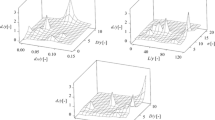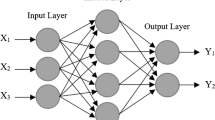Abstract
The accurate simulation of wall and bed shear stresses in rectangular channels is one of the most important topics in hydraulic engineering. In this study, the support vector machine (SVM) soft computing technique is utilized to simulate the shear stress in a rectangular channel with rough boundaries. In the modeling procedure, eight different SVM models with linear, sigmoid, polynomial, multi-quadratic, Gaussian, rational quadratic, exponential and Laplacian kernel functions are examined. Finally, the different input combinations are assessed to introduce the most accurate SVM models in wall and bed shear stress prediction, whose output programs are also presented. The results are compared with experimental data and other researchers’ equations, and it is found that the SVM models with RMSE of 0.0447 and 0.0566 in wall and bed stress prediction, respectively, outperform previous equations.








Similar content being viewed by others
References
Knight DW (1981) Boundary shear in smooth and rough channels. J Hydraul Div 107(7):839–851
Knight DW, Demetriou JD, Hamed ME (1984) Boundary shear stress in smooth rectangular channel. J Hydraul Eng 10(4):405–422
Tominaga A, Nezu I, Ezaki K, Nakagawa H (1989) Three dimensional turbulent structure in straight open channel flows. J Hydraul Res 27:149–173
Knight DW, Sterling M (2000) Boundary shear in circular pipes partially full. J Hydraul Eng 126(4):263–275
Atabay S, Knight DW, Seckin G (2004) Influence of a mobile bed on the boundary shear in a compound channel. Proc Int Conf River Flow Napoli Italy 1:337–345
Bilgil A (2005) Correlation and distribution of shear stress for turbulent flow in a smooth rectangular open channel. Hydraul Res 43(2):165–173
Ardiklioghlo M, Seckin G, Yurtal R (2006) Shear stress distribution along the cross section in smooth and rough open channels flow. Kuwait J Sci Eng 33(1):155–168
Pechlivanidis GI, Keramaris E, Pechlivanidis IG, Samaras GA (2014) Shear stress estimation in the linear zone over impermeable and permeable beds in open channels. Desalin Water Treat 54(8):2181–2189
Einstein HA (1942) Formulas for the transportation of bed-load. Trans ASCE 107(2140):561–597
Khodashenas SR, Paquier A (1999) A geometrical method for computing the distribution of boundary shear stress across irregular straight open channel. J Hydraul Res 37:381–388
Guo J, Julien PY (2005) Shear stress in smooth rectangular open-channel flow. J Hydraul Eng 131(1):30–37
Zarrati AR, Jin YC, Karimpour S (2008) Semianalytical model for shear stress distribution in simple and compound open channels. J Hydrol Eng 134(2):205–215
Yang SQ, Lim SY (2006) Boundary shear stress distribution in trapezoidal channels. J Hydraul Res 43(1):98–102
Kabiri-Samani A, Farshi F, Chamani MR (2013) Boundary shear stress in smooth trapezoidal open channel flows. J Hydraul Eng 139(2):205–212
Khozani ZS, Bonakdari H (2016) A Comparison of five different models in predicting the shear stress distribution in straight compound channels. Sientia Iranica (in press)
Sterling M, Knight DW (2002) An attempt at using the entropy approach to predict the transverse distribution of boundary shear stress in open channel flow. J Stoch Environ Res Risk Assess 16:127–142
Sheikh Z, Bonakdari H (2015) Prediction of boundary shear stress in circular and trapezoidal channels with entropy concept. J Urban Water 13(6):629–636
Bonakdari H, Sheikh Z, Tooshmalani M (2015) Comparison between Shannon and Tsallis entropies for prediction of shear stress distribution in circular open channels. J Stoch Environ Res Risk Assess 29(1):1–11
Bonakdari H, Tooshmalani M, Sheikh Z (2015) Predicting shear stress distribution in rectangular channels using entropy concept. Int J Eng 28(3):360–367
Ghosh SN, Roy N (1970) Boundary shear distribution in open channel flow. J Hydraul Div 96(4):967–994
Nezu I, Nakagawa H (1993) Turbulence in open channel flows. International Association for Hydraulic Research Monograph, Brookfield
Knight DW, Yuen KWH, Al Hamid AAI (1994) Boundary shear stress distributions in open channel flow. In: Beven K, Chatwin P, Millbank J (eds) Physical mechanisms of mixing and transport in the environment. Wiley, New York, pp 51–87
Bilgil A, Altun H (2008) Investigation of flow resistance in smooth open channels using artificial neural networks. Flow Meas Instrum 19(6):404–408
Guyal P, Chowdhury S, Agnihotri K (2014) Modelling of angle of shearing resistance using support vector machines. Int J Eng Res Technol 3(3):2478–2481
Khozani ZS, Bonakdari H, Zaji AM (2016) Application of a genetic algorithm in predicting the percentage of shear force carried by walls in smooth rectangular channels. Measurement 87:87–98
Khozani ZS, Bonakdari H, Zaji AM (2016) Application of soft computing technique in prediction percentage of shear force carried by walls in rectangular channel with non-homogenous roughness. Water Sci Technol 73(1):124–129
Cimen M (2008) Estimation of daily suspended sediments using support vector machines. J Hydrol Sci 53:656–666
Azamathulla HM, Wu FC (2011) Support vector machine approach for longitudinal dispersion coefficients in natural streams. Appl Soft Comput 1:2902–2905
Kisi O (2013) Least squares support vector machine for modeling daily reference evapotranspiration. Irrig Sci 31:611–619
Kakaei Lafdani E, Moghaddam Nia A, Ahmadi A (2013) Daily suspended sediment load prediction using artificial neural networks and support vector machines. J Hydrol 478:50–62
Nikam V, Gupta K (2014) SVM-based model for short-term rainfall forecasts at a local scale in the Mumbai Urban area, India. J Hydrol Eng 19(5):1048–1052
Hamedi O, Poorolajal J, Sadeghifar M, Abbasi H, Maryanaji Z, Faridi HR, Tapak L (2014) A comparative study of support vector machines and artificial neural networks for predicting precipitation in Iran. Theor Appl Climatol 119(3–4):723–731
Flintham TP, Carling PA (1988) The prediction of mean bed and wall boundary shear in uniform and compositely rough channels. In: Proceedings of international conference on river regime. Wiley, pp 267–287
Vapnik V (2000) The nature of statistical learning theory, 2nd ed. Springer, ISBN-13: 978-0387987804
Funding
All authors declare that there is no funding in the current study.
Author information
Authors and Affiliations
Corresponding author
Ethics declarations
Conflict of interest
All authors declare that they have no conflict of interest.
Human and animal rights
This article does not contain any studies with human participants performed by any of the authors.
Rights and permissions
About this article
Cite this article
Khozani, Z.S., Bonakdari, H. & Zaji, A.H. Estimating shear stress in a rectangular channel with rough boundaries using an optimized SVM method. Neural Comput & Applic 30, 2555–2567 (2018). https://doi.org/10.1007/s00521-016-2792-8
Received:
Accepted:
Published:
Issue Date:
DOI: https://doi.org/10.1007/s00521-016-2792-8




